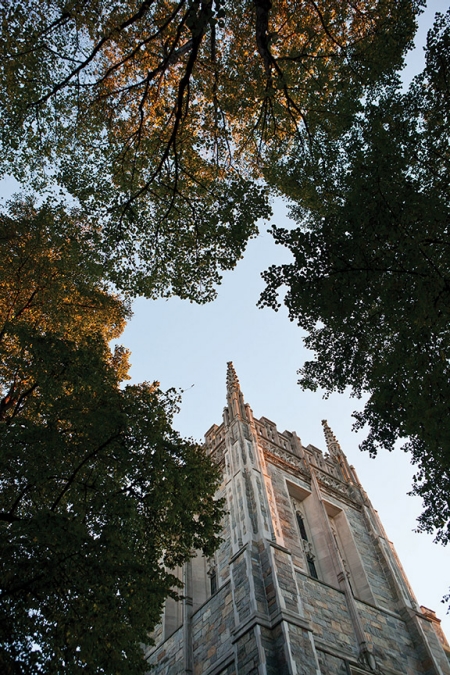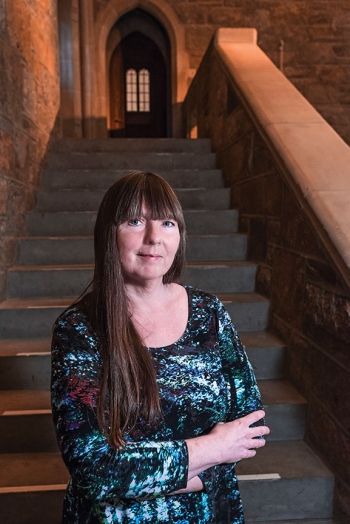
By
Who is Margaret Ford? And why is one of Boston College’s most iconic landmarks named in her honor?
Those questions have puzzled University historians, archivists, students and alumni for decades. But Shelley Barber, reference and archives specialist in the John J. Burns Library, thinks she has found at least some of the answers.
Ford Tower – one of BC’s legendary “Towers on the Heights” – is located on the northeast corner of Bapst Library, where this magnificent collegiate Gothic edifice is the entryway into the University Archives in the Burns Library section of Bapst. Ford Tower is also the first example of the University’s classic architecture to welcome visitors entering the campus through Linden Lane and an elegant sentinel overlooking the Boston College Veterans Memorial Wall and the University Memorial Labyrinth.
A renovation and restoration of Ford Tower’s stately stonework and lofty spires – scheduled to be completed later this fall – helped prompt Barber to engage in her research into the tower’s namesake.
For years, campus legend held that Ford Tower was named to honor an Irish washerwoman who donated her life savings to the University in the 1920s to assist the completion of Bapst Library as the primary study and research facility on BC’s still-new and growing Chestnut Hill campus.
That legend is not altogether wrong, asserts Barber, who has worked in the University Archives for the past 16 years, and who spent her own time on nights and weekends researching Margaret Ford.
“Margaret Ford had actually been a successful milliner [hat-maker] on Newbury Street in downtown Boston, and it looks like she had done a pretty good job in looking out for herself and her family,” Barber says. “She had made investments through a family friend that made her a very rich woman. But, by the time BC ‘met her,’ so to speak, she was elderly and was not working as a milliner.
“She was, however, taking in boarders in her Back Bay home and probably did not appear to be quite as fabulous as she had been at age 45 or 50, when she would have been described as a ‘successful Boston businesswoman’ or something,” Barber says. The idea that she had boarders living in her home in her retirement likely gave rise to the story that she was a domestic servant.
Barber, who often dabbles in genealogy and family histories and admits to having a special interest in 19th-century Boston history, researched a number of women named Margaret Ford who lived in the city at that time. She zeroed in on a young immigrant from New Brunswick, Canada, who had grown up in Lowell and then moved to Boston to open her own millinery shop, which proved to be quite successful.
“There was a lot of fundraising going on at BC in those days and a lot of people gave money to the school,” Barber adds. “Margaret attended the Immaculate Conception Church in the South End, which was not a parish church, but was staffed by Jesuit priests. She does not seem to have a relative who attended BC or have some of the other tie-ins that you might normally expect.”
Barber was able to pinpoint this Margaret Ford’s date of death in 1926, and she petitioned for a copy of Ford’s will in Suffolk Probate Court. When Barber received the document, the mystery was pretty much solved.

“That was the clincher,” Barber said, noting that Margaret Ford left about $18,000 cash and a large portfolio of stocks to BC – enough for the University to complete the construction of Bapst, which opened in 1928. “That was a pretty good amount of money in those days. If she had lived a little longer she might have lost it in the [1929] stock market crash and BC might not have gotten it.”
Barber is not sure if BC ever did get the money from Ford’s will, since there is no record of the cash ever having been received. She did discover correspondence from one of Ford’s relatives – also named Margaret Ford – to then-University President James H. Dolan, SJ.
“When I went looking for clues, there was one letter in Fr. Dolan’s papers that said ‘I am writing to you about my late cousin, Margaret Ford, and that you are going to bring the matter up with the Board of Trustees.’ We don’t know what her question was,” Barber says, “but it might have been about the naming of the tower.
“Back in that time period, if anyone gave BC over a thousand dollars they would say, ‘We’re going to put your name on a plaque.’ Most of those names are on a plaque still in the library, but her name is not there. I have not found direct evidence that BC got the money – she left it in the will and they named the tower after her, so you have to assume that BC actually got the money. But I never found anything in the trustees’ records about them getting it. You can find evidence of BC receiving the money in just about every other case.
“I thought that it was a really neat story, with all the little pieces of it, and the fact that there still is some mystery around it,” Barber says.
“We have a beautiful building with a fabulous tower and it’s named after a woman that nobody knew anything about,” Barber adds. “And what was said about her seemed to diminish her in some ways. It’s not that there is anything the matter with being a washerwoman, but the fact that it was all anyone could say – and it seemed like guesswork – was really aggravating to me.
“There’s not much on this campus named after women. It seemed like a fairly important thing and somehow we had lost track of it.”



